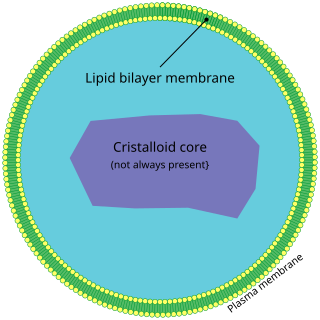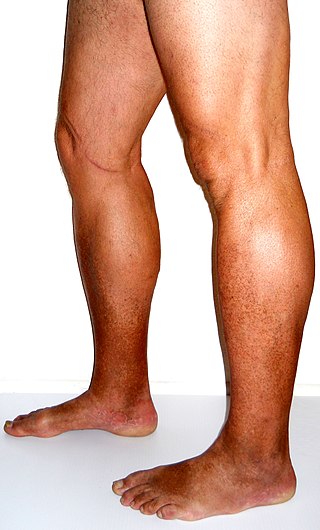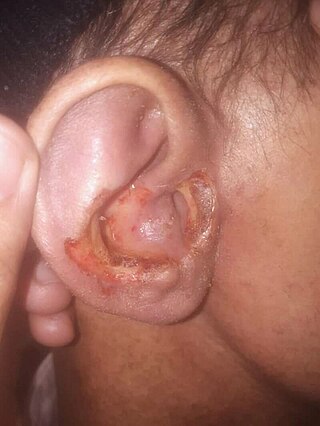
A mouth ulcer (aphtha), or sometimes called a Canker sore, is an ulcer that occurs on the mucous membrane of the oral cavity. Mouth ulcers are very common, occurring in association with many diseases and by many different mechanisms, but usually there is no serious underlying cause. Rarely, a mouth ulcer that does not heal may be a sign of oral cancer. These ulcers may form individually or multiple ulcers may appear at once. Once formed, an ulcer may be maintained by inflammation and/or secondary infection.

Werner syndrome (WS) or Werner's syndrome, also known as "adult progeria", is a rare, autosomal recessive disorder which is characterized by the appearance of premature aging.
Pseudoalteromonas is a genus of marine bacteria. In 1995, Gauthier et al proposed Pseudoalteromonas as a new genus to be split from Alteromonas. The Pseudoalteromonas species that were described before 1995 were originally part of the genus Alteromonas, and were reassigned to Pseudoalteromonas based on their rRNA-DNA analysis.

A rectal prolapse occurs when walls of the rectum have prolapsed to such a degree that they protrude out of the anus and are visible outside the body. However, most researchers agree that there are 3 to 5 different types of rectal prolapse, depending on whether the prolapsed section is visible externally, and whether the full or only partial thickness of the rectal wall is involved.

Gastrointestinal diseases refer to diseases involving the gastrointestinal tract, namely the esophagus, stomach, small intestine, large intestine and rectum; and the accessory organs of digestion, the liver, gallbladder, and pancreas.

Buruli ulcer is an infectious disease characterized by the development of painless open wounds. The disease is limited to certain areas of the world, most cases occurring in Sub-Saharan Africa and Australia. The first sign of infection is a small painless nodule or area of swelling, typically on the arms or legs. The nodule grows larger over days to weeks, eventually forming an open ulcer. Deep ulcers can cause scarring of muscles and tendons, resulting in permanent disability.

Aphthous stomatitis, or recurrent aphthous stomatitis (RAS), commonly referred to as a canker sore, is a common condition characterized by the repeated formation of benign and non-contagious mouth ulcers (aphthae) in otherwise healthy individuals.

Pyoderma gangrenosum is a rare, inflammatory skin disease where painful pustules or nodules become ulcers that progressively grow. Pyoderma gangrenosum is not infectious.

Venous ulcer is defined by the American Venous Forum as "a full-thickness defect of skin, most frequently in the ankle region, that fails to heal spontaneously and is sustained by chronic venous disease, based on venous duplex ultrasound testing." Venous ulcers are wounds that are thought to occur due to improper functioning of venous valves, usually of the legs. They are an important cause of chronic wounds, affecting 1% of the population. Venous ulcers develop mostly along the medial distal leg, and can be painful with negative effects on quality of life.

Acatalasia is an autosomal recessive peroxisomal disorder caused by absent or very low levels of the enzyme catalase. Catalase breaks down hydrogen peroxide in cells into water and oxygen. Low levels of catalase can cause hydrogen peroxide to build up, causing damage to cells.
Alteromonas is a genus of Pseudomonadota found in sea water, either in the open ocean or in the coast. It is Gram-negative. Its cells are curved rods with a single polar flagellum.

Chronic venous insufficiency (CVI) is a medical condition in which blood pools in the veins, straining the walls of the vein. The most common cause of CVI is superficial venous reflux which is a treatable condition. As functional venous valves are required to provide for efficient blood return from the lower extremities, this condition typically affects the legs. If the impaired vein function causes significant symptoms, such as swelling and ulcer formation, it is referred to as chronic venous disease. It is sometimes called chronic peripheral venous insufficiency and should not be confused with post-thrombotic syndrome in which the deep veins have been damaged by previous deep vein thrombosis.

PAPA syndrome is a rare genetic disorder characterised by its effects on skin and joints. The acronym PAPA stands for pyogenic arthritis, pyoderma gangrenosum and acne.

Trigeminal trophic syndrome is a rare disease caused by the interruption of peripheral or central sensory pathways of the trigeminal nerve. A slowly enlarging, uninflamed ulcer can occur in the area that has had trigeminal nerve damage; including but not limited to the cheek beside the ala nasi.

Behçet's disease (BD) is a type of inflammatory disorder which affects multiple parts of the body. The most common symptoms include painful sores on the mucous membranes of the mouth and other parts of the body, inflammation of parts of the eye, and arthritis. The sores can last from a few days, up to a week or more. Less commonly there may be inflammation of the brain or spinal cord, blood clots, aneurysms, or blindness. Often, the symptoms come and go.

A diabetic foot disease is any condition that results directly from peripheral artery disease (PAD) or sensory neuropathy affecting the feet of people living with diabetes. Diabetic foot conditions can be acute or chronic complications of diabetes. Presence of several characteristic diabetic foot pathologies such as infection, diabetic foot ulcer and neuropathic osteoarthropathy is called diabetic foot syndrome. The resulting bone deformity is known as Charcot foot.

Epizootic ulcerative syndrome (EUS), also known as mycotic granulomatosis (MG) or red spot disease (RSD), is a disease caused by the water mould Aphanomyces invadans. It infects many freshwater and brackish fish species in the Asia-Pacific region and Australia. The disease is most commonly seen when there are low temperature and heavy rainfall in tropical and sub-tropical waters.
Fresh water skin disease (FWSD) is a disease of marine cetaceans in coastal and estuarine environments, caused when they are exposed for extended periods to water with lower than normal levels of salt (hypo-saline). It has been observed in dolphins that were displaced into freshwater lakes, and in normally-salty lakes and estuaries where salinity has dropped suddenly due to flooding or storm runoff.














